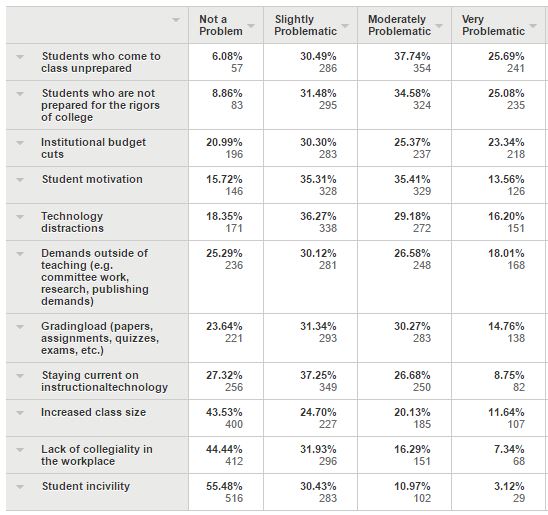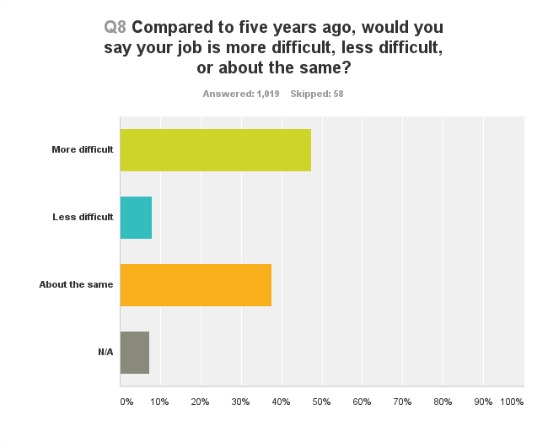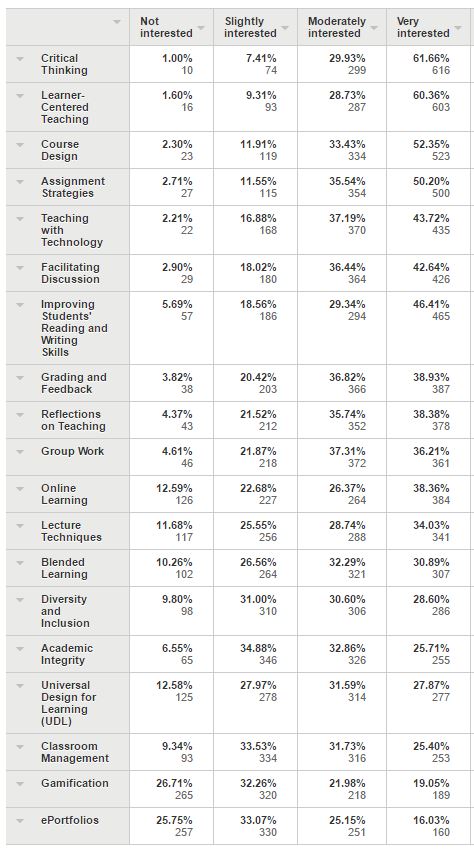Quick, what’s your biggest teaching challenge? If you said it’s students who don’t read their assignments or prepare for class, you’re in good company. For the fourth consecutive year that we posed that question in our survey, Faculty Focus readers identified students who come to class unprepared as their biggest day-to-day challenge. It was followed closely by students who are not prepared for the rigors of college. Finishing third this year was institutional budget cuts, which edged out student motivation for the first time. Technology distractions remained as the fifth biggest challenge.
What are some of your biggest day-to-day challenges? Please rate these issues.
As a follow-up to this question, readers were given the option to share some of the other challenges they face on a regular basis. Here are just some of the comments we received:
- Students inappropriately matched to field of study
- New fanatical focus on ADA compliance.
- Working with international students who don’t know English well or students who come to seminary poorly prepared to work at a graduate level
- I face the challenge of being new to being faculty while changing courses, trying to get comfortable with one course then being moved to another course.
- Students who they “deserve” a higher grade (entitlement mentality)
- Figuring out what to cut, what to keep. Wanting to add more, but knowing less is more. Not over-revising a course but still keeping it fresh enough to be interesting for me. How to apply retrieval practice & testing effect, but not have too many quizzes/exams/assignments.
- Teaching grad courses to students with wildly different amounts of academic preparation. Some are at a 6th grade level for writing! Others are on target.
- Lack of support from administration. Many teachers no longer feel valued. They feel replaceable.
- Mostly, I think I cause a lot of my own challenges– trying to do too much within a course, or assignments that take a lot of my help-time. Need to work on that!
- Expanding interdisciplinary teaching in the sciences; restructuring courses for project and problem-based learning
- Transitioning away from traditional lecturing
- Time management between big teaching load, committee work, student organizations, adjunct work for different institutions and graduate work.
- Coping with constant staff turnover. My university (indeed, much of Ireland) is affected by a preponderance of short-term contracts. These make ongoing faculty development work very problematic
- Student attendance, the complication of students’ lives outside of the classroom, demands of the institution to remain rigorous and maintain enrollment
- A campus culture in which sharp-elbowed competitiveness and disrespect chokes creativity, conversation, and collaboration.
- Student attendance in class; involving students in discussion; making the material challenging but not difficult
- Practical application of research-driven learning theories
- Student fear of failure—rather not try at all than try and risk something going wrong
- Work/life balance. Need to publish despite a heavy teaching and administrative load
- Balancing my teaching load with my role as Teaching Center Coordinator; trying to motivate faculty to move beyond lecture and PPT.
- Reaching students in a meaningful way in the online environment.
- Administrative pressures about student retention and students not failing.
- Keeping students engaged during long class laboratory and clinical experiences
- Management of increased numbers of students who receive individual accommodations for disabilities. These numbers are greatly increasing and take a lot of time to do accommodative notes, tests, and other resources.
- Disdain toward adjunct faculty from full time faculty; lack of university resources available to part-time faculty
- Students lack of creativity and desire to make an effort.
- Keeping online class discussions “real.” Trying to vary the assignments for online classes and face-to-face classes so that they are engaging.
- Grading papers in a timely fashion; giving students valuable and pertinent feedback on all of their assignments; creating new and exciting lectures for different courses (I teach in several different disciplines)
- Poor reading and writing skills in the students
- Lack of office space (no storage for student files and papers) because I’m an adjunct, lack of private space to meet with students
- Having time just to read about new directions in pedagogy, technology, and course design
- Lack of institutional support for faculty development.
- Dealing with the demonizing of higher education. Dealing with discussions about higher education that are looking for the “magic bullet” single solution to a complex, organic entity…
- A good challenge daily: to know if my students are understanding and how I need to adjust my teaching to respond to their mistakes.
Compared to five years ago, would you say your job is more difficult, less difficult, or about the same?
Since we started asking this question in 2013, there’s been little change in the percentage of readers who say their job is more difficult than it was five years ago. It continues to hover at around 50%. This year, 47.30% said “more difficult;” compared with 48.38% in 2014 and 50% in 2013. More than a third (37.59%) said “about the same,” 7.85% said “less difficult,” and for 7.26% the question didn’t apply.
Repondents were given the option to elaborate on their selection. The majority of those who took this opportunity seemed to be feeling the pressure of larger teaching loads, extra demands outside the classroom, or changes in the type of students they’re teaching. Here’s a sampling of what they told us:
- Online education takes more time than teaching in the classroom, students expect immediate answers when emailing or texting, even on the weekends and nights.
- There are more issues to deal with especially that relating to students’ mental health.
- Students who perceive their failure to study/learn as my failure to teach and so they should receive higher grades than they’ve earned.
- I teach seniors who are motivated to graduate and love their major.
- The administration has become very top-down and does not believe that faculty are capable of making best-practice decisions for their own courses.
- With increased class size comes more work all around, and with few instructors on campus there are more committee obligations.
- Volume and scope of work has intensified as we experience significant growth in courses and student numbers, but I have learned a lot and am much better at it.
- We went from small group, learner focused teaching to large classrooms. It is much more difficult to establish relationships with students and to promote a positive classroom atmosphere.
- All of the other requirements (committees, meetings, etc.) take a lot of time—more than previously, AND having everything available online even for face-to-face classes is also time-consuming.
- I would say the challenges have balanced out. I have some things that are definitely more difficult than they were five years ago, such as moving to hybrid classes and greater demands on my time. At the same time, some things are easier, as my online classes are very smooth, and technology is keeping up with what I need.
- More and more paperwork for “accountability” that takes time away from the real work of teaching and research.
- Though technology is a great resource, it comes with a new set of problems.
- I would say it’s more challenging. Expanded responsibilities and lack of support with implementing and using technology in the classroom.
- With years of teaching, one gains confidence, so it is somewhat easier. However, in my field, sociology, that which we study changes fast and hence we must constantly adapt to new concerns and changing outlooks.
- Due to faculty cuts and increased adjunct use, workload and addition responsibilities have significantly increased.
During the past year, have you engaged in the following?
Using rubrics, integrating technology, redesigning courses, and participating in faculty development remain the top activities for readers year-to-year. For the second time, nearly 85% said they used a rubric. Roughly three-fourths (77.52%) redesigned a course and incorporated technology into their course (74.32%)—two endeavors that are likely related. The number of readers who attended a professional development workshop or conference dropped from 85.81% in 2014 to 77.94% this year.
Article topics of interest
In an effort to ensure we continue to provide our readers with precisely the type of content they want, we asked survey respondents to rate 19 potential article topics. The top five topics were critical thinking (61.66% very interested and 29.93% moderately interested), learner-centered teaching (60.36% very interested and 28.73% moderately interested), course design (52.35% very interested and 33.43% moderately interested), assignment strategies (50.20% very interested and 35.54% moderately interested), and teaching with technology (43.72% very interested and 37.19% moderately interested. The topics that received the least interest were, in order, eportfolios, gamification, classroom management, universal design for learning (UDL), and academic integrity.
SURVEY DEMOGRAPHICS
How many years have you worked in higher education?
The survey was completed by 1,065 readers, the majority of whom bring a wealth of experience. Nearly a third (31%) have more than 20 years of experience and another 16.04% have 16-20 years of experience. Readers with fewer than five years of experience make up 15.21%, six to 10 years of experience was at 22.4%, and those 11 to 15 years of experience make up 15.1%.
Which best describes your institution?
As far as where readers teach, the majority (34.1%) teach at four-year public institutions and another 25.75% teach at four-year private institutions. Two-year public institutions make up 20.57%, following by 3.77% who are at for-profit institutions, and 1.98% at two-year private institutions. A surprising 13.77% said “other,” which included everything from medical schools, three-year institutions, vocational schools, government agencies, and non-profit organizations.
What country do you currently reside in?
Nearly 80% (79.68%) of readers live in the United States, while Canadians make up 6.84%. The remaining 13.49% of readers are scattered across the globe, with Australia, India, New Zealand, South Africa, Malaysia, and the Philippines mentioned most frequently.
What is your role in higher education?
This question had a large number of possible responses. Readers were clustered fairly equally across the top four responses: instructor/lecturer (15.86 percent), full professor (15.3%), associate professor (13.79%), and assistant professor (12.0%). Faculty developer/instructional designer (10.6%), adjunct (10.4%), program director (4.35%) dean/provost/VP (3.4%) and department chair (2.9%) were also represented. The remaining 11.05 % selected “other,” which included a wide variety of professionals, such as librarians, writing center directors, academic advisors, clinical instructors, professors emeriti, and directors.
Thanks to everyone who took the time to complete the survey. We appreciate all of the insight and feedback we received and will use it to continue to improve Faculty Focus throughout the coming years.








